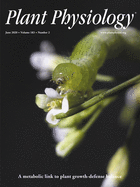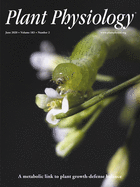
Cover image

Volume 183, Issue 2, June 2020
ON THE INSIDE
On the Inside
NEWS AND VIEWS
Mix, Match, and Maize: A Synthetic System for Maize Nuclear Auxin Response Circuits
NLR-Annotator: A Tool for De Novo Annotation of Intracellular Immune Receptor Repertoire
Functional Analysis of Mitochondrial Acyl Carrier Proteins
Pollen Tubes Use Matrix Rigidity to Direct Growth
A New Order through Disorder: Intrinsically Disordered Proteins Reshape the Cytoskeleton under Drought Stress
Extreme Engineering: How Antarctic Algae Adapt to Hypersalinity
Small But Powerful: MicroRNA-Derived Peptides Promote Grape Adventitious Root Formation
Ripened by Redox: Sulfoxidation of NOR Regulates Tomato Ripening
Gearing Up the Clock of Hypocotyl Growth!
Remorins: Essential Regulators in Plant-Microbe Interaction and Cell Death Induction
To Grow or Defend? More on the Plant Cornelian Dilemma
Sweet or Sour? Important Link between Nitrate Signaling and Malate Accumulation Identified in Apple
The Rhythm of the Light: How Light and the Clock Drive Cycling of Transcript Levels in Barley
Trapped in the Rhizosheath: Root-Bacterial Interactions Modulate Ethylene Signaling
SPLICEd in the Seeds: Integration of Abscisic Acid and Light Signaling in Arabidopsis
LETTERS
Echinochloa colona with Reported Resistance to Glyphosate Conferred by Aldo-Keto Reductase Also Contains a Pro-106-Thr EPSPS Target Site Mutation
Echinochloa with resistance to glyphosate also contains an unreported Pro-106-Thr EPSPS target-site mutation.
Membrane Inlet Mass Spectrometry at the Crossroads of Photosynthesis, Biofuel, and Climate Research
Advances in algal biology have built on gas exchange measurements by MIMS in the fields of photosynthesis, biofuel production, and climate research.
Virus-Mediated Transient Expression Techniques Enable Gene Function Studies in Black-Grass
Virus-mediated transient expression techniques create loss- and gain-of-function mutations in black-grass with genotype specificity and measurable changes in herbicide resistance.
Is the Structure of the CO2-Hydrating Complex I Compatible with the Cyanobacterial CO2-Concentrating Mechanism?
The structure of CO2 hydration complex I is not compatible with the view on how this complex is embedded and functions in the cyanobacterial carbon-concentrating mechanism.
PscB: A Browser to Explore Plant Single Cell RNA-Sequencing Data Sets
The Plant Single Cell RNA-Sequencing Browser, with its comprehensive visualization tools, provides a resource to explore expression information in scRNA-Seq data.
BREAKTHROUGH TECHNOLOGIES, TOOLS AND RESOURCES
The NLR-Annotator Tool Enables Annotation of the Intracellular Immune Receptor Repertoire
The wheat intracellular immune receptor repertoire can be explored with the NLR-Annotator tool.
RESEARCH ARTICLES
BIOCHEMISTRY AND METABOLISM
mGWAS Uncovers Gln-Glucosinolate Seed-Specific Interaction and its Role in Metabolic Homeostasis
mGWAS of Gln-related traits reveals an unexpected seed-specific interaction between glutamine and glucosinolates and in shaping the metabolic homeostasis in Arabidopsis seeds.
Omics Data Reveal Putative Regulators of Einkorn Grain Protein Composition under Sulfur Deficiency
Sulfur deficiency in einkorn grain leads to upregulation of genes acting in sulfur transport and metabolism that may coordinate the pool of free amino acids necessary for storage protein synthesis.
Dual-Localized Enzymatic Components Constitute the Fatty Acid Synthase Systems in Mitochondria and Plastids
Mitochondria- and plastid-localized fatty acid synthase systems share three enzymatic components, products of dual-targeted gene expression.
Glyceollin Transcription Factor GmMYB29A2 Regulates Soybean Resistance to Phytophthora sojae
Two homologous transcription factors have opposite roles in regulating accumulation of the soybean phytoalexin glyceollin I to provide resistance to Phytophthora.
Mitochondrial Fatty Acid Synthase Utilizes Multiple Acyl Carrier Protein Isoforms
Three partially redundant acyl carrier protein isoforms support mitochondrial fatty acid biosynthesis.
CELL BIOLOGY
Durotropic Growth of Pollen Tubes
Pollen tube growth in the style is guided by an active mechanoresponsive system that is sensitive to the stiffness and resistance of the growth path.
An Intrinsically Disordered Protein Interacts with the Cytoskeleton for Adaptive Root Growth under Stress
Rice REPETITIVE PROLINE-RICH PROTEIN affects cytoskeletal reorganization, cell wall remodeling, and sucrose synthase activity as an adaptive response to water deficit in rice roots.
ECOPHYSIOLOGY AND SUSTAINABILITY
Chlamydomonas sp. UWO 241 Exhibits High Cyclic Electron Flow and Rewired Metabolism under High Salinity
High cyclic electron flow is associated with photoprotection, up-regulation of carbon fixation, and shikimate pathways in the halotolerant psychrophile, Chlamydomonas sp. UWO 241.
Rapid Chlorophyll a Fluorescence Light Response Curves Mechanistically Inform Photosynthesis Modeling
Chlorophyll a fluorescence rapid light response curves improve mechanistic models of drought limitations to photosynthetic electron transport.
GENES, DEVELOPMENT AND EVOLUTION
The Peptide Hormone Receptor CEPR1 Functions in the Reproductive Tissue to Control Seed Size and Yield
CEP receptor signaling in maternal tissues controls the delivery of nitrogen to reproductive sinks.
Insights into the Diversification and Evolution of R2R3-MYB Transcription Factors in Plants
Gene duplications within a specific subfamily led to the expansion of one of the largest transcription factor families in land plants.
A miRNA-Encoded Small Peptide, vvi-miPEP171d1, Regulates Adventitious Root Formation
In grapevines, a microRNA-encoded peptide specifically increases the expression of the miRNA that encodes it and enhances the number of adventitious roots of tissue culture plantlets.
Redox Regulation of the NOR Transcription Factor Is Involved in the Regulation of Fruit Ripening in Tomato
Sulfoxidation of NON-RIPENING transcription factor regulates tomato fruit ripening by decreasing its DNA binding capacity and transcriptional regulatory activity.
Pseudo Response Regulators Regulate Photoperiodic Hypocotyl Growth by Repressing PIF4/5 Transcription
Pseudo Response Regulator proteins and the Evening Complex transmit daylength information to regulate photoperiodic hypocotyl growth by directly repressing transcription of key growth regulators.
MEMBRANES, TRANSPORT AND BIOENERGETICS
Cytochrome cM Decreases Photosynthesis under Photomixotrophy in Synechocystis sp. PCC 6803
A cryptic, highly conserved cytochrome accelerates inhibition of photosynthesis in Synechocystis under long-term photomixotrophy.
SIGNALLING AND RESPONSE
SlREM1 Triggers Cell Death by Activating an Oxidative Burst and Other Regulators
A tomato remorin protein causes cell death by increasing the accumulation of reactive oxygen species and other defense factors.
A Phytochrome B-Independent Pathway Restricts Growth at High Levels of Jasmonate Defense
A phytochrome B-independent pathway restricts growth at high levels of defense, and this growth inhibition is correlated with dysregulation of tryptophan biosynthesis.
BTB-TAZ Domain Protein MdBT2 Modulates Malate Accumulation and Vacuolar Acidification in Response to Nitrate
Under high nitrate, BT2 ubiquitinates a bHLH transcription factor, reducing malate-associated gene transcription levels, thus controlling malate accumulation and vacuolar acidification.
Differential Effects of Day/Night Cues and the Circadian Clock on the Barley Transcriptome
Based on diel and circadian leaf transcriptomes in barley wild-type and clock mutant lines we predicted a structure of the barley circadian oscillator and interactions of its individual components with day/night cues.
Root-Bacteria Associations Boost Rhizosheath Formation in Moderately Dry Soil through Ethylene Responses
The associations between roots and bacteria are important for rhizosheath formation in rice plants under moderate soil drying and involve the ethylene response.
DRT111/SFPS Splicing Factor Controls Abscisic Acid Sensitivity during Seed Development and Germination
Arabidopsis DNA-DAMAGE REPAIR/TOLERATION PROTEIN111/SPLICING FACTOR FOR PHYTOCHROME SIGNALING regulates pre-mRNA splicing in seeds, affecting ABA-mediated responses.


